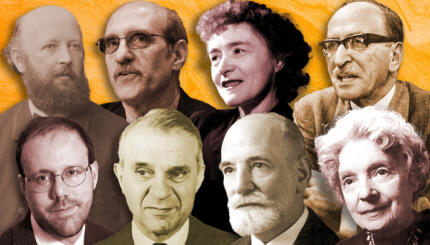Reprinted with permission from Jbooks.com.
Unlike other masters of the short story–say, Bernard Malamud, in whose Complete Stories we witness the author’s approach shifting regularly and unpredictably, or Grace Paley, whose Collected Stories manifests relatively stable interests and methods–Leonard Michaels transformed his style dramatically, if gradually, during his career. Reading him chronologically in the new Collected Stories, beginning with the work he composed in the early ‘60s and continuing through the final publications before his death in 2003, the evolution of Michaels’ oeuvre stares you smack in the face.
Abstract Flights of Virtuosity
Michaels began to publish while still a grad student at the University of Michigan, writing a dissertation on Lord Byron. The early pieces dazzle with their verbal vitality and evocation of the manic atmosphere of the ‘60s, palpable especially on college campuses. A few have conventional plots–"Manikin," the collection’s powerful opener, describes the rape and suicide of a rabbi’s daughter–but more commonly Michaels’ work revels in dialogue, in intimated emotions, in abstract flights of lyric virtuosity.
Michaels’ autobiographical stand-in and frequent protagonist is a young man named Phillip Liebowitz. In "Making Changes" he tries to fit in at a group sex party; he’s told that marriage is "an antisocial perversion" and that "on the other hand, orgies are liberal, humane." In "Fingers and Toes" he involves himself again with an ex-girlfriend while her current boyfriend speaks to them through the door. Reports on the dizzying sexual politics of the ‘60s, these stories provide opportunities for Michaels to lay on a thick poetic style. The latter tale ends, more or less characteristically, with the narrator slipping "out into the night": "I twitched like a fish," he says, "and went quivering through dingy dingles, from blackness to blackness to blackness to blackness." Here, as in other moments in Michaels’ work, rhythm trumps logic.
That first collection, Going Places, earned Michaels mixed reviews (a few readers were bewildered by Michaels’ "verbal jazz") but it scored him a teaching gig at Berkeley, where he would remain for decades. His next collection, I Would Have Saved Them If I Could, included some similar pieces–including the often-anthologized "Murderers," about boys who spy on a rabbi and his wife from the roof of an apartment building, and "Getting Lucky," in which a man is brought to orgasm by a stranger’s hand while on the subway–as well as several in a new mode. "Eating Out," "Downers," and the title story are each comprised of a dozen or so short sections, pithily titled; the sections don’t necessarily relate to one another in any obvious sense, relying instead on the subtler mechanics of a symphony–repetition, juxtaposition, counterpoint–to achieve their larger effects. These stories, as well as freestanding pieces like "Trotsky’s Garden" and "Annabella’s Hat," play not only on Michaels’ standard New York milieu but also on historical events and personages ranging from Byron to Kafka, and vary in tone from farce to tragedy.
"In the Fifties," another classic in the second collection, isn’t broken into small chunks but drives forward with similar intensity and compression. Structured almost like a stand-up routine, the story draws on autobiographical details: "I read literary reviews the way people suck candy"; "I heard of parties in Ann Arbor where everyone made it with everyone else, including the cat"; "I used to think that someday I would write a fictional version of my stupid life in the fifties."
Disconnected autobiographical fragments, hilarious or sad, also make up "Journal," a long piece taken from Shuffle, which Michaels called a volume of "autobiographical fiction." The anecdotes recorded here take as long as they need to take: sometimes a couple of pages, sometimes a paragraph, sometimes a single line. One, in its entirety, reads: "I phoned my mother. She said, ‘You sound happy. What’s the matter?’"
What seems to have been happening is that Michaels’ early style–with its focus on syntax, sharp detail, and narratives boiled down to their barest bones–led him to write fiction with minimal mediation between a story as it appears on the page and the same story as it would be told aloud. Characters are introduced by name, without further description, as in a conversation between old friends. Having dispensed with the conventions of the form (for example, the one that says stories have to clock in somewhere between 2,500 and 10,000 words), Michaels brings to the center of his work the tiny intensities of regular life, filtered just barely in the name of linguistic precision. This is fiction as stylized as it can be without forgoing plot entirely. Michaels seemed headed for a minimalism far removed from conventional realism.
Then something happened. It might have had to do with Anatole Broyard’s savaging of Shuffle in the New York Times ("a shockingly bad book," he called it), or it might have been Michaels’ age, or something in the zeitgeist. Whatever the cause, beginning in the early ‘90s, Michaels enthusiastically took up, for the first time, the standard conventions of American realist fiction.
The results appeared in To Feel These Things and A Girl with a Monkey: "Honeymoon" tells a Catskills story of fraught love, complete with a tense handball match and Yinglish dialogue. In "A Girl with a Monkey" and "Viva La Tropicana," Michaels leads his protagonists to Germany and Cuba, respectively, entangles them with family and love interests, and impels the plot with suspense: in other words, he avails himself of all the tactics of standard realism. Though partisans of ‘60s experimentalism may feel betrayed by this turn, I suspect a majority of readers will appreciate these later pieces more than the earlier ones, as they’re rich in setting, emotional detail, and plot–they’re easy to like. The trade-off is that the abstraction and idiosyncratic rhythms of the earlier fiction, the intense quirkiness that distinguished Michaels’ prose, has been shifted from the center of attention to an occasional sidelight.
In the final stories he published before his death, Michaels takes this new conventionalism even further: his recurring protagonist from the period, a UCLA mathematician named Nachman, not only exists within conservatively structured narratives, but is something of a conservative himself: "frugal by nature, [he] had no lust to consume the world, and he didn’t feel one was enlarged or made wise by experience." A bachelor, Nachman lives comfortably on an academic salary and has but one hobby, gambling on horse races. The tales dispatch Nachman to Cracow, to New York, and to the barber, confronting him with awkward or challenging or poignant situations. The conflicts could be described as textbook: Will young Nachman write an essay on Henri Bergson, as he has promised to do, for a rich and charming classmate? Should Nachman tell his best friend that he has caught that man’s wife in the midst of adultery? None of this would be noteworthy if Michaels’ early work had not so deliberately avoided all such expected elements of conventional short fiction.
Why did Michaels’ style change so starkly, so late in the game? What’s perhaps most important about The Collected Stories is that it insistently provokes this question, which probably will not be answered satisfyingly until someone publishes a thoughtful critical biography of the author. In the meantime, there is delight to be found on just about every page in this book–even at its most befuddling, Michaels’ prose is comical and stirring in its lyricism, and even at his most conventional, he’s sharp and witty. Michaels’ admirers and protégés are legion (David Bezmozgis, an impressive young story writer, is one), and for good reason: neither the most prolific nor the most accessible of the great Jewish-American short story writers, he was, perhaps, the most honest.


